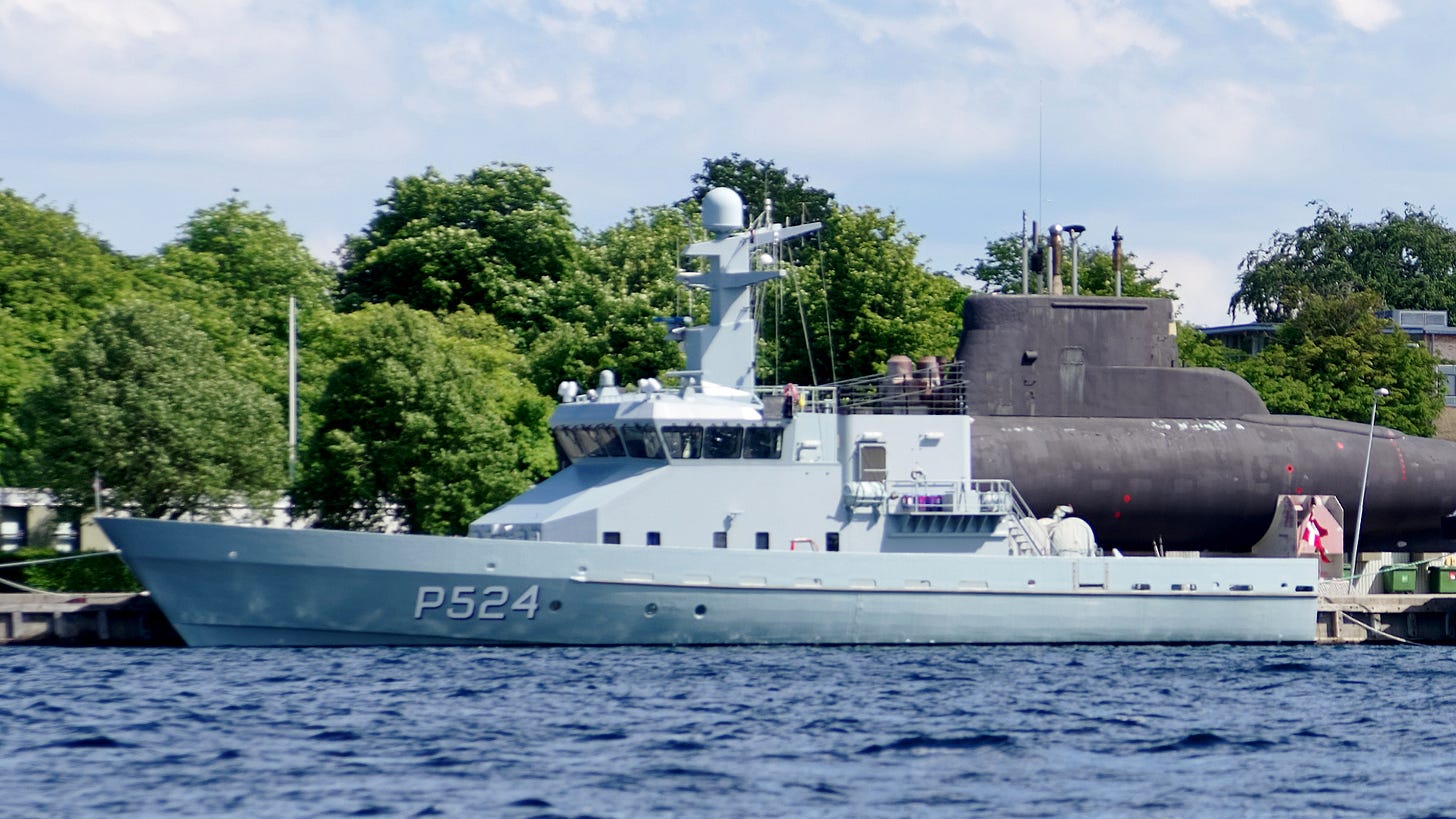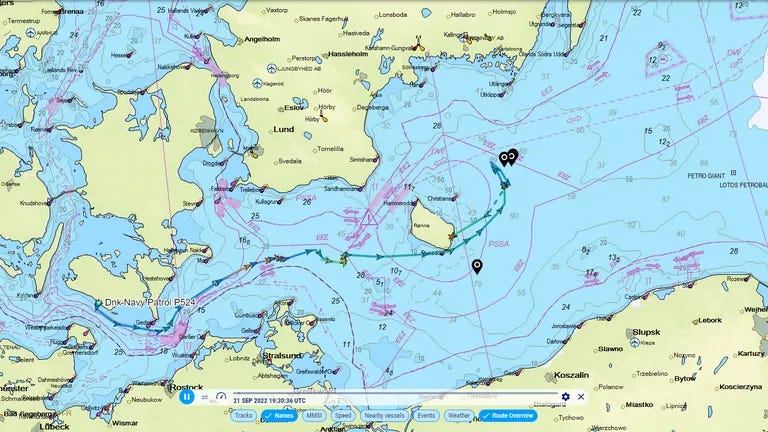Danish Dynamite
If the Danes knew the Russians had destroyed German critical infrastructure, why didn't NATO react?

According to a story by the German news site T-Online1, the Russians blew up the Nord Stream pipelines. This directly contradicts an investigative report veteran journalist Seymour Hersh2 published in February that says the US Navy destroyed Nord Stream, acting on a plan by the CIA under direct orders from President Joe Biden. I’ve discussed this report by Sy Hersh in detail on my podcast The Private Citizen:
The T-Online piece is the second story that contradicts Sy Hersh, the first one — published by The New York Times and Die Zeit, among others — alleged that Ukrainian citizens chartered a yacht and blew up the pipelines. That story has been discounted as highly unlikely by just about every independent expert in the matter and Sy Hersh reported that it is in fact a CIA cover story. Even though Hersh can’t prove it, I feel that his conspiracy theory is more likely than the story actually being true. Conspiracies like that are, after all, what the CIA gets its funding from the American taxpayer for. I’ve also discussed this cover story theory at length on my podcast. You can listen to it here, in case you need to catch up:
Just like the Times and Die Zeit with the first story, T-Online is claiming in their piece that they did some investigative research into the Nord Stream attack. According to a story they published on 25 March, they discovered that a coastal patrol vessel of the Royal Danish Navy, P524 Nymfen, visited the site of the eventual pipeline explosion in the night of 21/22 September 20223. There, the Nymfen reportedly discovered Russian Navy vessels and chased them, supported by further Danish sea and air forces, towards the naval base in the Russian enclave of Kaliningrad. The Russian Navy forces, according to T-Online, “operated like ghosts” — by which the authors of the story are trying to tell us that the ships weren’t transmitting AIS signals, I guess4.

The story of suspicious “dark ships” at the site of the explosion prior to the attack isn’t new — Wired reported on this in November. T-Online’s information of the Nymfen’s chase of Russian boats is, though. And unlike the Ukrainian yacht story, the journalists involved this time actually admit they were tipped of to this theory by “security circles” — i.e. contacts from an intelligence service. Public AIS data seems to show the Nymfen on a patrol route to the area of the pipeline attack and later on a course towards Kaliningrad, but this could be part of a false flag operation. T-Online, in their story, does not address this possibility or why their journalists might have discounted it.
In the follow-up story published by T-Online today, the publication quotes new information that apparently came to light in the Danish daily newspaper Information. The Information story says the Royal Danish Navy took 112 photos of the Russian ships that Nymfen encountered. This is according to the Danish Ministry of Defence. The photos will remain classified to protect “intelligence work”, say the Danes. T-Online takes this as further proof that their research is correct. To me, this actually makes it look even more like a false flag operation designed to blame the Russians and get the US Navy off the hook. A second attempt to distract from Sy Hersh who, presumably, reported the truth. Interestingly, T-Online does mention Hersh in their story and claims his “blog post” is “presumed to be untrustworthy and has been largely discounted”.
I would like to know why Sy Hersh is less trustworthy than a relatively-unknown German journalists who’s largely written stories that are mostly noteworthy for being sensationalist, rather than incredible research5. I also find it peculiar that T-Online maligns Hersh's Substack publication as a "blog" to make it seem like it is unimportant. T-Online might have millions of readers for their advertising-supported content, but Hersh has tens of thousands of paying subscribers. T-Online doesn’t publish numbers for its own paid, ad-reduced subscription services, but I am willing to bet Sy Hersh is outperforming them on this front. In any case, his version of what happened to the Nord Stream pipelines makes a hell of of a lot more sense to me than T-Online’s. Not that T-Online, or any other publication, actually has undertaken serious efforts to actually “discount” Sy Hersh’s work as far as I can tell. That would have started with asking the US government if they blew up the pipelines and forcing them to answer the question by not letting them deflect towards why Sy Hersh is untrustworthy.
I am much more inclined to believe an independent journalist with a proven track record and anonymous sources over a large media (and advertising) organisation that trades in secrets given to them by intelligence services. Glenn Greenwald gives a good overview of the problem of journalists taking stories and materials from the intelligence community in his commentary on the Discord leaks:
I trust nothing that comes from an intelligence service. These people are actually paid to lie. Why would any journalist believe anything given to them through official or semi-official channels from such a source?
Why Didn’t NATO React?
But, let’s for a moment assume the T-Online story is actually true. Let’s assume the Russians blew up Nord Stream and the Danish Navy caught them red-handed. And they didn’t tell anyone? Or they told their NATO allies and NATO did nothing? How does this make sense? The Russian Navy blows up German critical infrastructure, just off the coast of Germany, on the territory of Denmark …Germany is a NATO member. So is Denmark. How is this not an act of war that would trigger Article 5 of the treaty? I don’t understand this. Why would Denmark keep this secret if they had proof? NATO being unable to defend a pipeline critical to German interests on the territory of Denmark would make this whole alliance useless, wouldn’t it? Why are we spending €53 billion a year on an alliance that doesn’t protect our strategic interests in the region? And why is nobody in the actual press, like T-Online, asking these questions? Why are only grimy Substack bloggers like Sy and myself on the case?
The more I think about this, the clearer it becomes that Germany got shafted either way. Either our so-called allies in the US blew up the pipelines — that is not exactly how allies behave, is it? — or the Russians did and NATO, who we pay about 2% of the country’s GDP to, just sat by and didn’t react. In either circumstance, Germany got royally fucked. And why exactly is it that our government is just accepting all of this? Without explaining it to the people who elected it? Oh yeah, I just remembered: Because they’re a bunch of incompetent idiots. And what’s even worse is the talented hacks who call themselves journalists at publications like T-Online actually protect the interests of these people.
T-Online, misleadingly, takes its name (under license) from my ISP Deutsche Telekom. It is, however, run by the huge German advertising company Ströer.
Seymour Hersh, among other things, is known for uncovering the Mỹ Lai massacre, the recovery of Soviet submarine K-129 by the Hughes Glomar Explorer and the torture scandal at Abu Ghraib. He has won a Pulitzer Prize and a grand total of five George Polk Awards — so he’s basically as experienced and as highly decorated as investigative journalists come.
The Nord Stream pipelines exploded in the early morning of 26 September.
While AIS is mandatory under International Maritime Organization (IMO) rules for all vessels exceeding 500 GT, for any vessel exceeding 300 GT that is on an “international voyage”, and for all passenger vessels, it is somewhat standard procedure for military vessels to turn the system off. Several NATO ships did this during the BALTOPS 22 exercise. The very exercise which, according to Sy Hersh, was used as cover for the US operation to blow up the pipelines.
Despite the IMO regulations, large civilian ships have also been known to operate without AIS at times.





